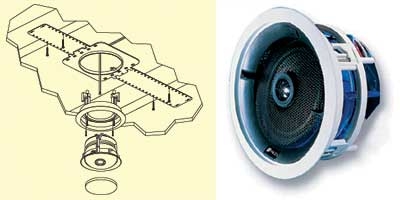The Case of the Invisible Speakers Page 3
Looking UpThe trend toward open architecture often means that there isn't a wall available for speakers. And if there is a free wall, the speakers have to compete for space with artwork, cabinetry, furniture, and other potential obstructions. That's where ceiling speakers come into play.  Both the tweeter and the woofer pivot independently in the Niles DS Directed Soundfield series of ceiling speakers. The mounting bracket allows the speaker location to be set before the sheetrock is in place.
Both the tweeter and the woofer pivot independently in the Niles DS Directed Soundfield series of ceiling speakers. The mounting bracket allows the speaker location to be set before the sheetrock is in place.
But even that solution has problems: ceiling speakers frequently have to be installed far from the main listening area, and even at irregular distances from it, to maintain symmetry with lighting fixtures. Sometimes they're even installed in vaulted ceilings, putting them at angles that might not be optimal.
"It's difficult to make a ceiling speaker whose sound is as well balanced as an in-wall's," says Atlantic Technology president Peter Tribeman. "When you're listening to in-wall speakers, you're for the most part facing them, just as we've been hearing speakers for years. But ceiling speakers fire downward and hit the top of the head before traveling down to the ears - making that sound right is a major challenge."
While these issues might not matter when ceiling speakers (or in-walls, for that matter) are used mainly for background music, they become important when these speakers are enlisted for more attentive listening, as in a home theater. Manufacturers are addressing in different ways the problem of changes in a speaker's tonal balance because of where it's placed, including the use of variable crossovers or switches to adjust how "hot" the tweeters sound. Niles, SpeakerCraft, and others use pivoting tweeters and woofers that can be separately adjusted to compensate for imaging problems arising from poor positioning. Niles calls its technology Directed Soundfield (DS), while SpeakerCraft sells its "directional" speakers under the AIM label.
"DS lets you direct the sound field into a room, effectively thwarting a lot of the problems that architects - and interior designers - give you," Niles's Detmer says. "So you can place a speaker where it looks best and still get great sound by directing it where you want, like aiming the spray from a shower. You can now create a whole home theater system using ceiling speakers, which just wasn't possible before."
But not everyone endorses that approach. Thiel, for example, tackles this problem by recommending its PowerPoint on-wall models featuring an angled coaxial driver. "If we used pivoting drivers, they couldn't be rigidly mounted in the baffle, and we think drivers need to be mounted extremely rigidly because you want all of the energy from the amplifier to go into moving the diaphragms, not vibrating the enclosure," Thiel president Kathy Gornik says. "You really want to anchor these things."
- Log in or register to post comments





























































